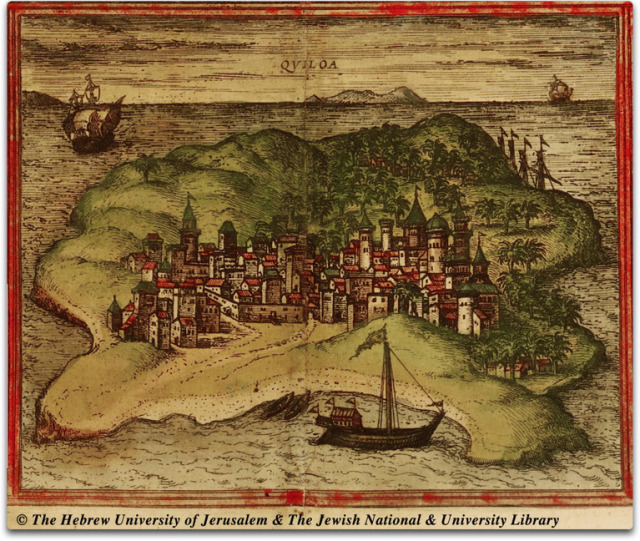The Wessel Coins #3: Kilwa and its Sultanate July 27, 2013
Author: Beach Combing | in : Contemporary, Medieval, Modern , trackbackKilwa (or Quiloa as it was often called in European sources) was a small almost-tidal island off the coast of Tanzania. ‘Almost tidal’ because in its early history there was allegedly a causeway and even in later centuries it was possible to wade to Kilwa at low tide. The city of Kilwa was a Muslim stronghold on the medieval African coast, dominating, with Mombassa and Mogadishu, trade with the interior. Indeed, Kilwa, Mombassa and Mogadishu were all quintessentially urban, trading posts, which depended on subject territories on adjacent islands and the mainland to supply them with agricultural goods: they are a strange tropical version of Renaissance Italian cities. In many ways Kilwa was the best situated of the three. After taking the mainland town of Sofala (from Mogadishu), Kilwa’s rulers had their foot into the door of Great Zimbabwe, which meant that they controlled the most important flow of gold in the eastern hemishphere and of ivory in the world. They also controlled a series of Muslim depots on Madagascar perhaps as early as the eleventh century. Did any Kilwans try and circumnavigate South Africa? Make no mistake they would have been up to it.
The origins of Kilwa are lost in myths. But for what it is worth… A Persian noble family were, in the ninth century, warned by a dream of an iron-nosed rat to escape from their home city. Seven sons took boats and the sixth arrived in Kilwa and set up a Sultanate there. He bought the island from a local Bantu ruler after wrapping coloured cloth around Kilwa. Now anyone who has ever had anything to do with origin legends will recognize the stink of non-history here. Was there a link with Persia? There are china and coins from China and goods from the Islamic world but precious few clues of any link with Iran. In fact, the principal links with the north were with Oman. The one Kilwan coin outside Africa has been found there (excluding of course the Wessel coins!) and an attempt dating perhaps from the twelfth or thirteenth century to drag Kilwa away from the heresy of Ghurabiyya Shi’ism began in Oman (or the general region). Why though the pretence of a connection to Persia? Was it actually a way to counteract Oman’s influence down the African coast, a kind of anyone-but-Oman posture?
If all this sounds excessively vague it is not the fault of the archaeologists. A famous dig here under the direction of Chittick found literally millions of objects in the soil. However, the dig just couldn’t penetrate far beyond about 1300. Indeed, it is striking that the history of Kilwa is extremely fragile before 1300 when wood not stone was preferred in construction. There are forty nine Sultans recorded in two sultan lists (which have slight political differences). Twenty of these are from before 1300, but should we take them on trust? Even the bare numbers are suspicious: 900-1200 twenty rulers; 1200-1506 almost thirty rulers. Certainly, the first dynasty the Shirazi, named for their supposed Persian origins are glowing with the radiation of legend. Nothing about it can be assumed to be true just because four or five hundred years later someone living on or near Kilwa wrote about them.
This brings us back to the Wessel coins. What can Kilwa tell us about those? Well, two things. First, there were some very weak suggestions, in an earlier phase of scholarship, that Kilwa coins were not really currency but tokens. This has been entirely disproved by subsequent archaeology. The Wessel coins could have been put in someone’s pocket to buy something. Second, the earliest certain Kilwa coins date back to the eleventh century. The idea, then, that, as many news reports suggested, the Kessel coins date back into the ninth century has to be taken with several shakers full of salt! There is ambiguity in the dating of some coins because of the repeated use of similar names for Sultans, but it is far more likely that most of the Kilwan coins on Wessel date to the thirteenth century. That dating has important consequences for the Wessel hoard.
Any other forgotten kingdoms: drbeachcombing AT yahoo DOT com



